belt Citroen JUMPER RELAY 2012 2.G Owner's Manual
[x] Cancel search | Manufacturer: CITROEN, Model Year: 2012, Model line: JUMPER RELAY, Model: Citroen JUMPER RELAY 2012 2.GPages: 184, PDF Size: 4.62 MB
Page 5 of 184
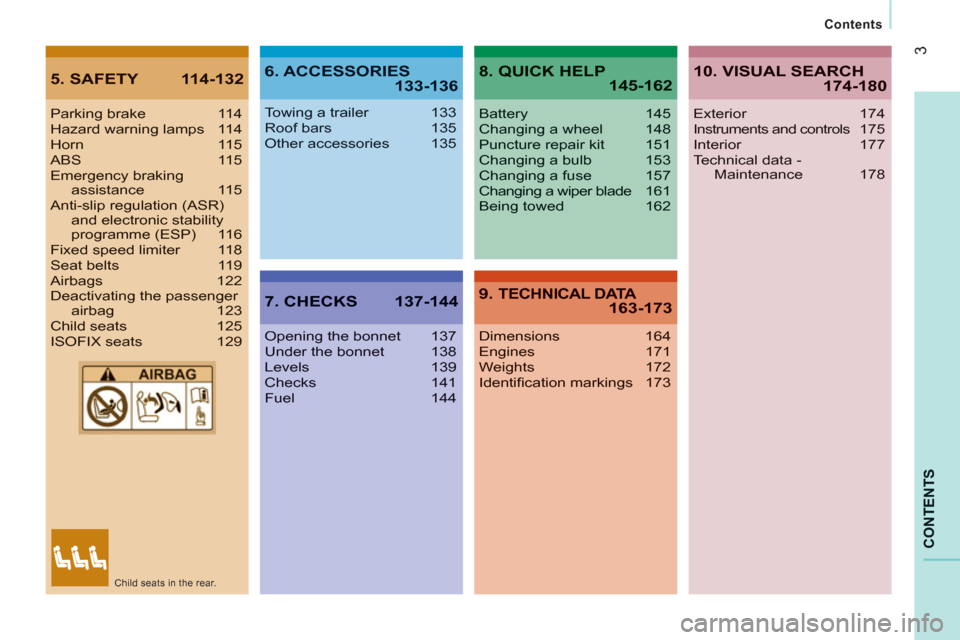
3
CONTENT
S
Contents
5. SAFETY 114-1326. ACCESSORIES133-136
7. CHECKS 137-144
8. QUICK HELP145-162
9. TECHNICAL DATA 163-173
Parking brake 114Hazard warning lamps 114Horn 115ABS 115Emergency brakingassistance 115Anti-slip regulation (ASR) and electronic stabilityprogramme (ESP) 116Fixed speed limiter 118Seat belts 119Airbags 122Deactivating the passenger airbag 123Child seats 125ISOFIX seats 129
Towing a trailer 133Roof bars 135Other accessories 135
Opening the bonnet 137Under the bonnet 138Levels 139Checks 141Fuel 144
Battery 145Changing a wheel 148Puncture repair kit 151Changing a bulb 153Changing a fuse 157Changing a wiper blade 161Being towed 162
Dimensions 164Engines 171Weights 172Identifi cation markings 173
10. VISUAL SEARCH 174-180
Exterior 174Instruments and controls175Interior 177Technical data - Maintenance 178
Child seats in the rear.
Page 13 of 184
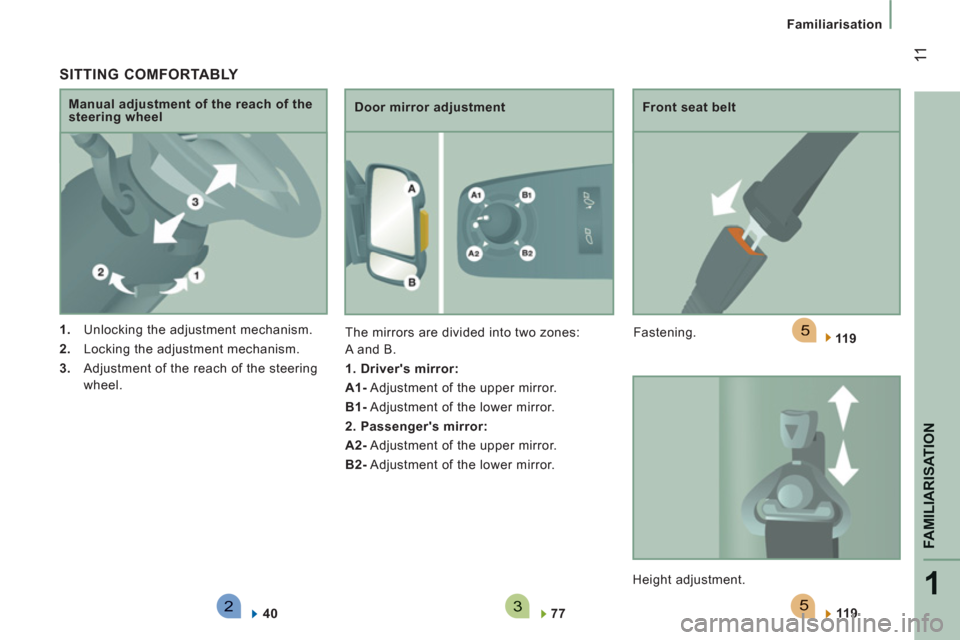
523
5
1
FAMILIARISATION
11
Familiarisation
SITTING COMFORTABLY
1.
Unlocking the adjustment mechanism.
2.
Locking the adjustment mechanism.
3.
Adjustment of the reach of the steering
wheel.
Manual adjustment of the reach of the
steering wheel
Door mirror adjustment
The mirrors are divided into two zones:
A and B.
1. Driver's mirror:
A1-
Adjustment of the upper mirror.
B1-
Adjustment of the lower mirror.
2. Passenger's mirror:
A2-
Adjustment of the upper mirror.
B2-
Adjustment of the lower mirror.
40
77
Front seat belt
Fastening.
Height adjustment.
11 9
11 9
Page 35 of 184
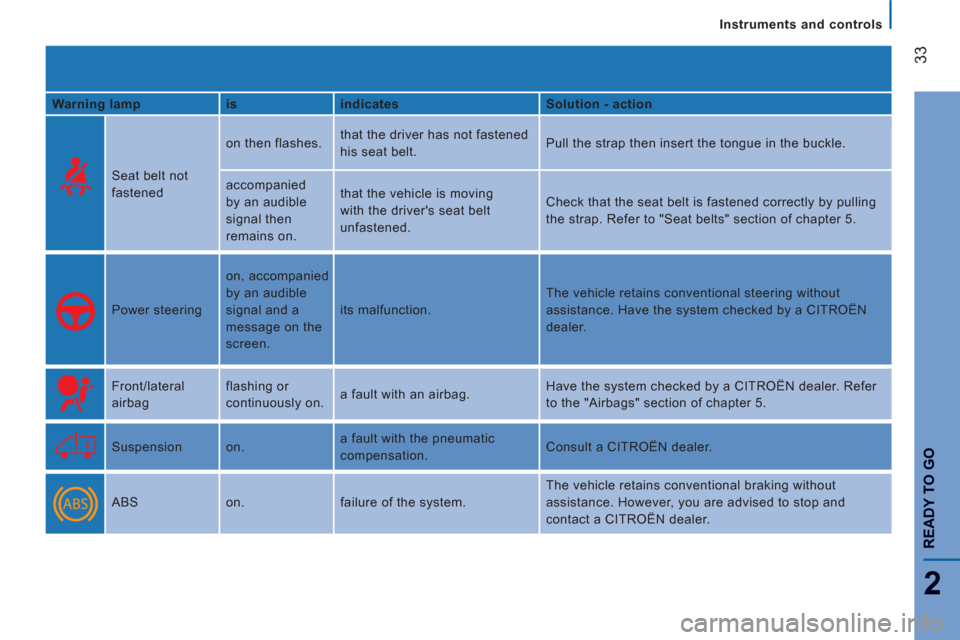
33
2
READY TO G
O
Instruments and controls
Warning lamp
is
indicates
Solution - action
Seat belt not
fastened on then flashes. that the driver has not fastened
his seat belt. Pull the strap then insert the tongue in the buckle.
accompanied
by an audible
signal then
remains on. that the vehicle is moving
with the driver's seat belt
unfastened. Check that the seat belt is fastened correctly by pulling
the strap. Refer to "Seat belts" section of chapter 5.
Power steering on, accompanied
by an audible
signal and a
message on the
screen. its malfunction. The vehicle retains conventional steering without
assistance. Have the system checked by a CITROËN
dealer.
Front/lateral
airbag flashing or
continuously on. a fault with an airbag. Have the system checked by a CITROËN dealer. Refer
to the "Airbags" section of chapter 5.
Suspension on. a fault with the pneumatic
compensation. Consult a CITROËN dealer.
ABS on. failure of the system. The vehicle retains conventional braking without
assistance. However, you are advised to stop and
contact a CITROËN dealer.
Page 45 of 184
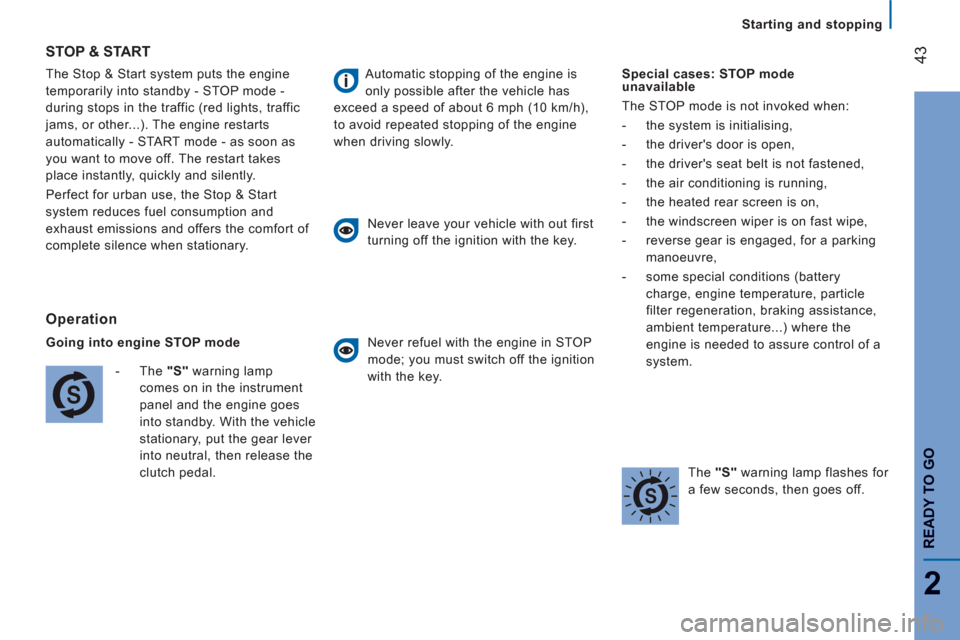
43
2
READY TO G
O
Starting and stopping
The Stop & Start system puts the engine
temporarily into standby - STOP mode -
during stops in the traffic (red lights, traffic
jams, or other...). The engine restarts
automatically - START mode - as soon as
you want to move off. The restart takes
place instantly, quickly and silently.
Perfect for urban use, the Stop & Start
system reduces fuel consumption and
exhaust emissions and offers the comfort of
complete silence when stationary.
STOP & START
O
peration
Going into engine STOP mode
- The "S"
warning lamp
comes on in the instrument
panel and the engine goes
into standby. With the vehicle
stationary, put the gear lever
into neutral, then release the
clutch pedal.
Automatic stopping of the engine is
only possible after the vehicle has
exceed a speed of about 6 mph (10 km/h),
to avoid repeated stopping of the engine
when driving slowly.
Never leave your vehicle with out first
turning off the ignition with the key.
Never refuel with the engine in STOP
mode; you must switch off the ignition
with the key.
Special cases: STOP mode
unavailable
The STOP mode is not invoked when:
- the system is initialising,
- the driver's door is open,
- the driver's seat belt is not fastened,
- the air conditioning is running,
- the heated rear screen is on,
- the windscreen wiper is on fast wipe,
- reverse gear is engaged, for a parking
manoeuvre,
- some special conditions (battery
charge, engine temperature, particle
filter regeneration, braking assistance,
ambient temperature...) where the
engine is needed to assure control of a
system.
The "S"
warning lamp flashes for
a few seconds, then goes off.
Page 46 of 184
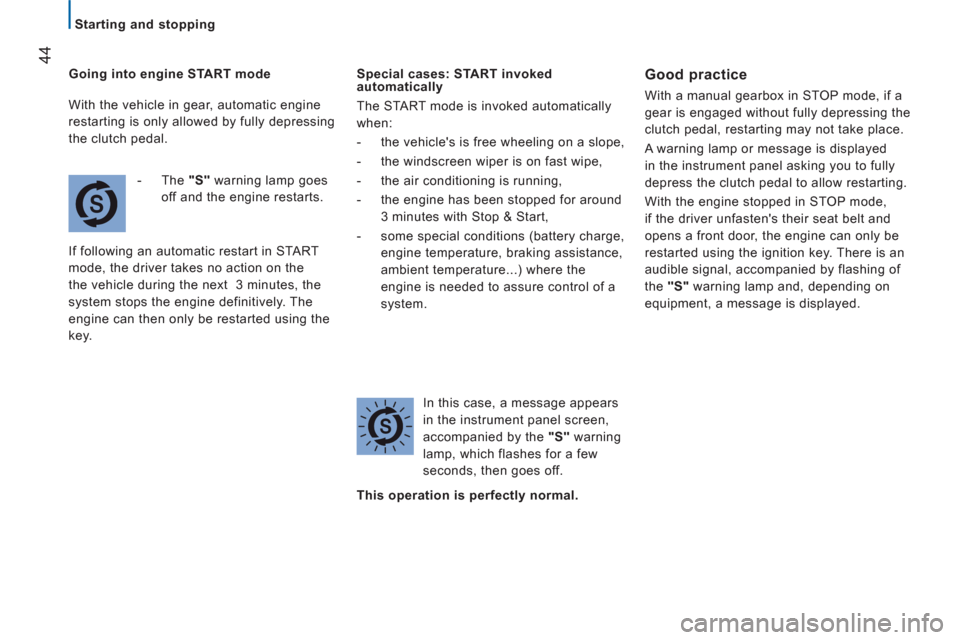
44
Starting and stopping
Going into engine START mode
- The "S"
warning lamp goes
off and the engine restarts.
If following an automatic restart in START
mode, the driver takes no action on the
the vehicle during the next 3 minutes, the
system stops the engine definitively. The
engine can then only be restarted using the
key.
Special cases: START invoked
automatically
The START mode is invoked automatically
when:
- the vehicle's is free wheeling on a slope,
- the windscreen wiper is on fast wipe,
- the air conditioning is running,
- the engine has been stopped for around
3 minutes with Stop & Start,
- some special conditions (battery charge,
engine temperature, braking assistance,
ambient temperature...) where the
engine is needed to assure control of a
system.
In this case, a message appears
in the instrument panel screen,
accompanied by the "S"
warning
lamp, which flashes for a few
seconds, then goes off.
Good practice
With a manual gearbox in STOP mode, if a
gear is engaged without fully depressing the
clutch pedal, restarting may not take place.
A warning lamp or message is displayed
in the instrument panel asking you to fully
depress the clutch pedal to allow restarting.
With the engine stopped in STOP mode,
if the driver unfasten's their seat belt and
opens a front door, the engine can only be
restarted using the ignition key. There is an
audible signal, accompanied by flashing of
the "S"
warning lamp and, depending on
equipment, a message is displayed.
This operation is perfectly normal.
With the vehicle in gear, automatic engine
restarting is only allowed by fully depressing
the clutch pedal.
Page 69 of 184
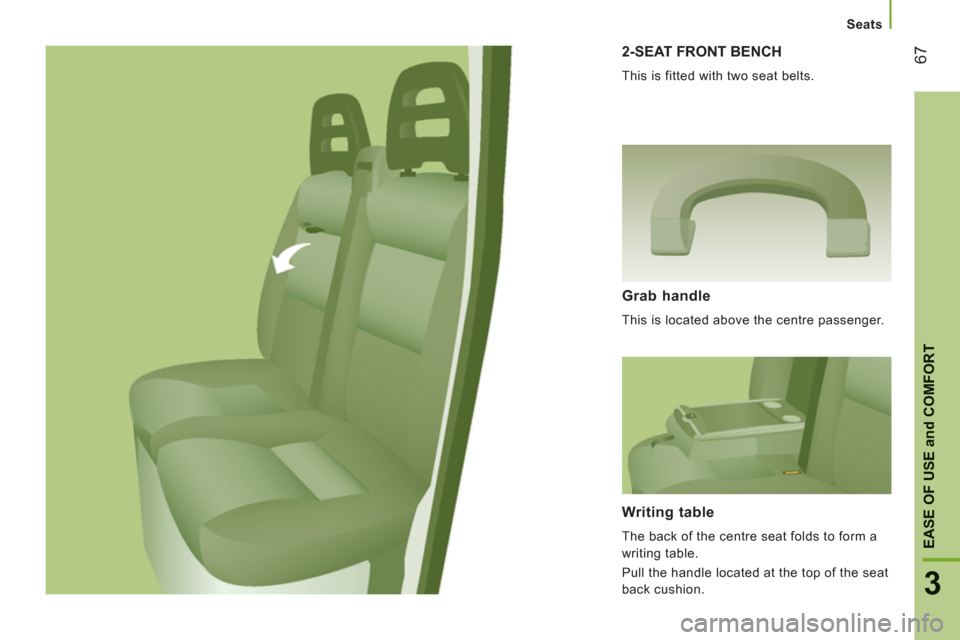
67
3
EASE OF USE
and
COMFOR
T
Seats
2-SEAT FRONT BENCH
This is fitted with two seat belts.
Grab handle
This is located above the centre passenger.
Writing table
The back of the centre seat folds to form a
writing table.
Pull the handle located at the top of the seat
back cushion.
Page 71 of 184
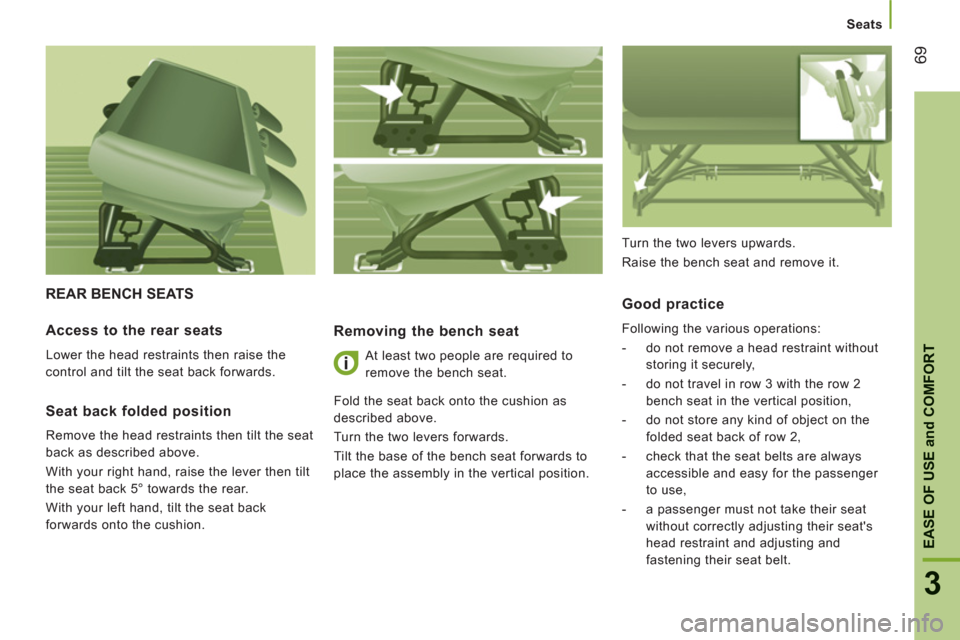
69
3
EASE OF USE
and
COMFOR
T
Seats
REAR BENCH SEATS
Removing the bench seat
At least two people are required to
remove the bench seat.
Fold the seat back onto the cushion as
described above.
Turn the two levers forwards.
Tilt the base of the bench seat forwards to
place the assembly in the vertical position.
Good practice
Following the various operations:
- do not remove a head restraint without
storing it securely,
- do not travel in row 3 with the row 2
bench seat in the vertical position,
- do not store any kind of object on the
folded seat back of row 2,
- check that the seat belts are always
accessible and easy for the passenger
to use,
- a passenger must not take their seat
without correctly adjusting their seat's
head restraint and adjusting and
fastening their seat belt.
Access to the rear seats
Lower the head restraints then raise the
control and tilt the seat back forwards.
Seat back folded position
Remove the head restraints then tilt the seat
back as described above.
With your right hand, raise the lever then tilt
the seat back 5° towards the rear.
With your left hand, tilt the seat back
forwards onto the cushion. Turn the two levers upwards.
Raise the bench seat and remove it.
Page 72 of 184
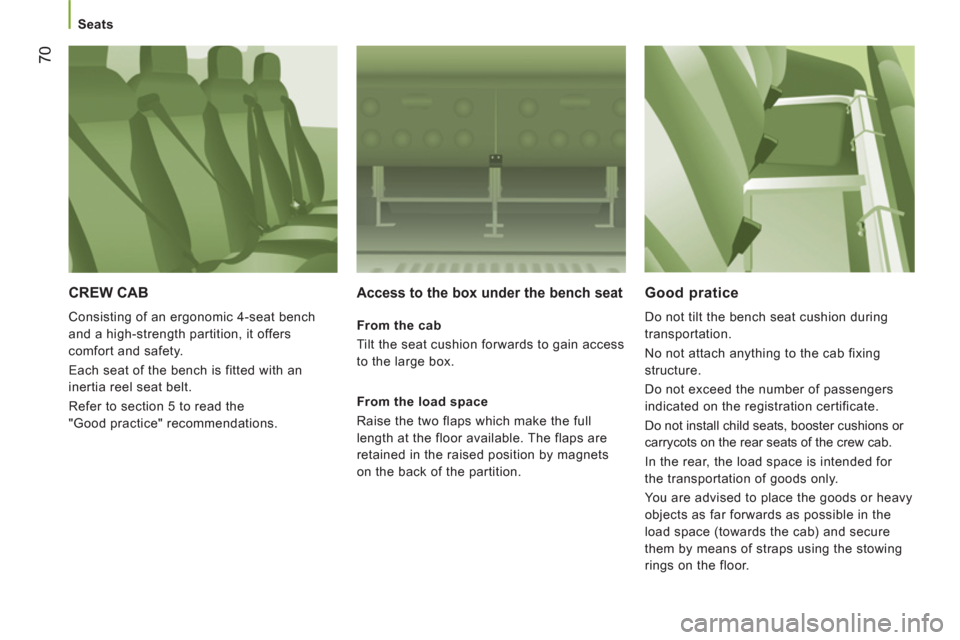
70
Seats
CREW CAB
Consisting of an ergonomic 4-seat bench
and a high-strength partition, it offers
comfort and safety.
Each seat of the bench is fitted with an
inertia reel seat belt.
Refer to section 5 to read the
"Good practice" recommendations.
Access to the box under the bench seat
From the cab
Tilt the seat cushion forwards to gain access
to the large box.
From the load space
Raise the two flaps which make the full
length at the floor available. The flaps are
retained in the raised position by magnets
on the back of the partition.
Good pratice
Do not tilt the bench seat cushion during
transportation.
No not attach anything to the cab fixing
structure.
Do not exceed the number of passengers
indicated on the registration certificate.
Do not install child seats, booster cushions or
carrycots on the rear seats of the crew cab.
In the rear, the load space is intended for
the transportation of goods only.
You are advised to place the goods or heavy
objects as far forwards as possible in the
load space (towards the cab) and secure
them by means of straps using the stowing
rings on the floor.
Page 121 of 184
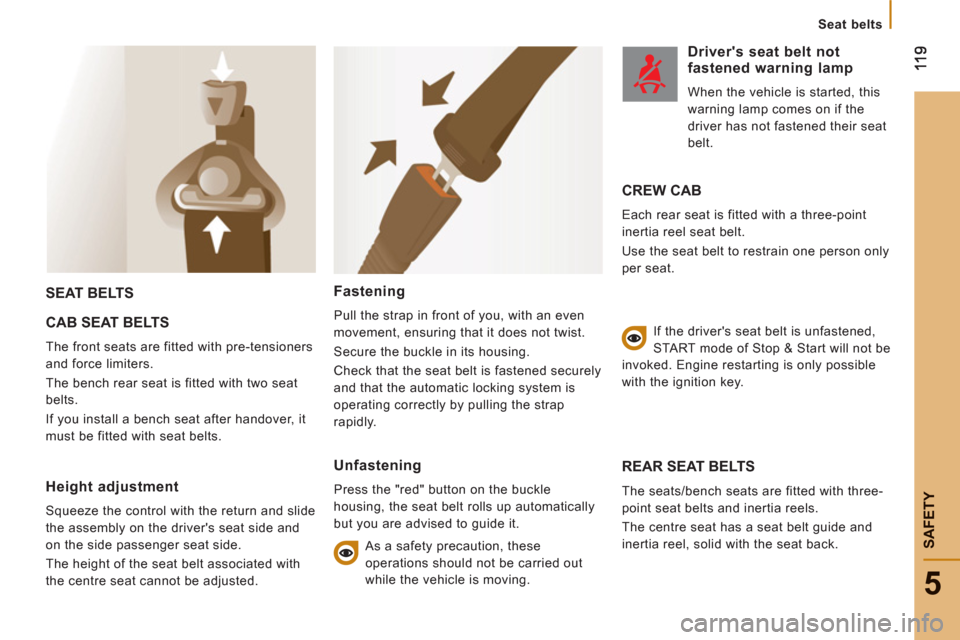
5
SAFETY
Seat belts
SEAT BELTS
CAB SEAT BELTS
The front seats are fitted with pre-tensioners
and force limiters.
The bench rear seat is fitted with two seat
belts.
If you install a bench seat after handover, it
must be fitted with seat belts.
REAR SEAT BELTS
The seats/bench seats are fitted with three-
point seat belts and inertia reels.
The centre seat has a seat belt guide and
inertia reel, solid with the seat back. Height adjustment
Squeeze the control with the return and slide
the assembly on the driver's seat side and
on the side passenger seat side.
The height of the seat belt associated with
the centre seat cannot be adjusted.
Fastening
Pull the strap in front of you, with an even
movement, ensuring that it does not twist.
Secure the buckle in its housing.
Check that the seat belt is fastened securely
and that the automatic locking system is
operating correctly by pulling the strap
rapidly.
Unfastening
Press the "red" button on the buckle
housing, the seat belt rolls up automatically
but you are advised to guide it.
As a safety precaution, these
operations should not be carried out
while the vehicle is moving.
Driver's seat belt not fastened warning lamp
When the vehicle is started, this
warning lamp comes on if the
driver has not fastened their seat
belt.
CREW CAB
Each rear seat is fitted with a three-point
inertia reel seat belt.
Use the seat belt to restrain one person only
per seat.
If the driver's seat belt is unfastened,
START mode of Stop & Start will not be
invoked. Engine restarting is only possible
with the ignition key.
Page 122 of 184
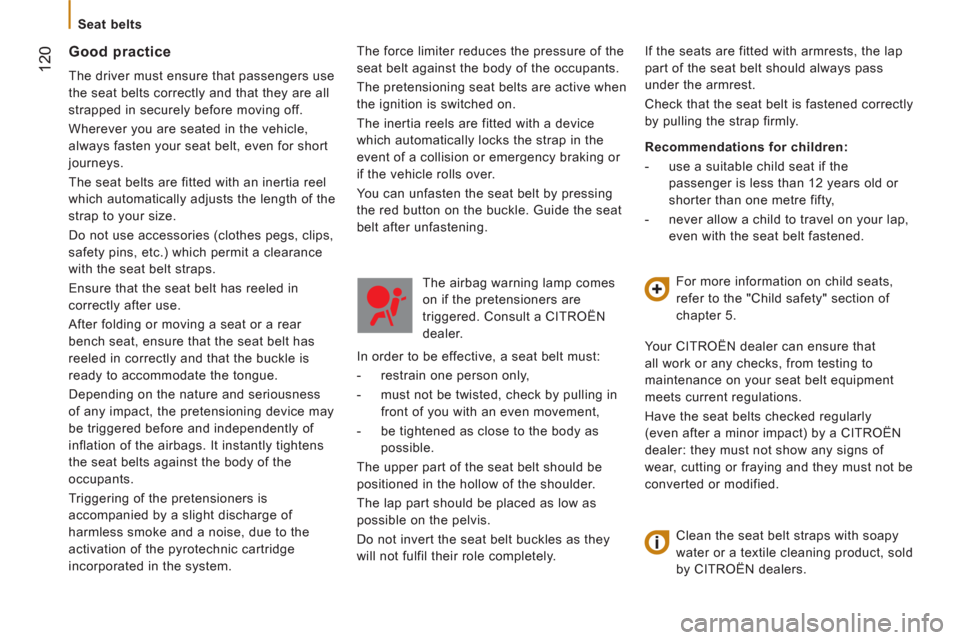
12
0
Seat belts
The force limiter reduces the pressure of the
seat belt against the body of the occupants.
The pretensioning seat belts are active when
the ignition is switched on.
The inertia reels are fitted with a device
which automatically locks the strap in the
event of a collision or emergency braking or
if the vehicle rolls over.
You can unfasten the seat belt by pressing
the red button on the buckle. Guide the seat
belt after unfastening.
Good practice
The driver must ensure that passengers use
the seat belts correctly and that they are all
strapped in securely before moving off.
Wherever you are seated in the vehicle,
always fasten your seat belt, even for short
journeys.
The seat belts are fitted with an inertia reel
which automatically adjusts the length of the
strap to your size.
Do not use accessories (clothes pegs, clips,
safety pins, etc.) which permit a clearance
with the seat belt straps.
Ensure that the seat belt has reeled in
correctly after use.
After folding or moving a seat or a rear
bench seat, ensure that the seat belt has
reeled in correctly and that the buckle is
ready to accommodate the tongue.
Depending on the nature and seriousness
of any impact, the pretensioning device may
be triggered before and independently of
inflation of the airbags. It instantly tightens
the seat belts against the body of the
occupants.
Triggering of the pretensioners is
accompanied by a slight discharge of
harmless smoke and a noise, due to the
activation of the pyrotechnic cartridge
incorporated in the system. The airbag warning lamp comes
on if the pretensioners are
triggered. Consult a CITROËN
dealer.
In order to be effective, a seat belt must:
- restrain one person only,
- must not be twisted, check by pulling in
front of you with an even movement,
- be tightened as close to the body as
possible.
The upper part of the seat belt should be
positioned in the hollow of the shoulder.
The lap part should be placed as low as
possible on the pelvis.
Do not invert the seat belt buckles as they
will not fulfil their role completely. If the seats are fitted with armrests, the lap
part of the seat belt should always pass
under the armrest.
Check that the seat belt is fastened correctly
by pulling the strap firmly.
Recommendations for children:
- use a suitable child seat if the
passenger is less than 12 years old or
shorter than one metre fifty,
- never allow a child to travel on your lap,
even with the seat belt fastened.
For more information on child seats,
refer to the "Child safety" section of
chapter 5.
Your CITROËN dealer can ensure that
all work or any checks, from testing to
maintenance on your seat belt equipment
meets current regulations.
Have the seat belts checked regularly
(even after a minor impact) by a CITROËN
dealer: they must not show any signs of
wear, cutting or fraying and they must not be
converted or modified.
Clean the seat belt straps with soapy
water or a textile cleaning product, sold
by CITROËN dealers.